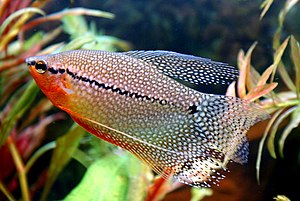Trichopodus
| Trichopodus | ||||||||||||
|---|---|---|---|---|---|---|---|---|---|---|---|---|

|
||||||||||||
| Systematics | ||||||||||||
|
||||||||||||
| Scientific name | ||||||||||||
| Trichopodus | ||||||||||||
| Lacépède , 1801 |
The genus Trichopodus ( syn .: Trichogaster ) includes labyrinth fish that are widespread throughout Southeast Asia .
features
In the representatives of this genus, the first ray of the ventral fin is drawn out like a thread, the other two to three rays are extremely shortened and barely visible. When put on, this thread extends to the base of the tail fin and has taste buds with which the fish can recognize conspecifics. In contrast to the thread fish of the genus Trichogaster , the dorsal fin is significantly shorter than the anal fin in the species of this genus. The body is between twelve and 20 cm long, depending on the species. Like most labyrinth fish, these also feed mainly on zooplankton such as small crustaceans , molluscs , insects and their larvae , as well as on approach food, i.e. insects that land on the surface of the water.
Occurrence
The original range of this genus can no longer be reliably reconstructed, but is probably on the Hinterinid peninsula and the Indonesian archipelago west of the Wallace Line . In the meantime, however, most of the species have spread far over southern Asia as a neozoon, due to their use as food fish .
The fish live in shallow, slow-flowing or stagnant waters that are shaded or densely overgrown. Some species are also found in rice fields .
Reproduction
For reproduction, the males occupy territories and build a foam nest between aquatic plants . The male lures a female ready to mate under the foam nest by courtship. When mating under the nest, depending on the species, several hundred to a few thousand swimming eggs are released, which rise into the nest by themselves due to their oil droplets. Then the immediate vicinity of the nest is guarded by the males and the females are driven out of the immediate vicinity. Depending on the temperature and species, the larvae hatch after 24–48 hours and are kept in the nest passively by an oily yolk sac and actively by the male. After a few days, the larvae leave the nest and are no longer cared for by the males .
use
In their homeland all representatives are used as food fish and some are bred. The blue shape of the spotted gourami and the mosaic gourami also count as aquarium fish to the standard range of pet shops. As a result, there are several cultivated forms of the spotted threadfish.
Systematics
The genus was established by Lacépède in 1801 without a type species and contained the spotted gourami and the giant gourami . Between 1829 and 1831 Cuvier separated the threadfish and giant gouramis into the genera recognized today. By 1879 at the latest, Bleeker established the spotted gourami as a type species for the eastern gourami under the generic name Trichopodus . However, the name Trichogaster was in use from 1923 until the end of the 20th century and is still very common today. The correct scientific name is Trichopodus and is also finding its way back into the scientific literature. The generic name indicates the thread-like ventral fins ("Thrix" = "hair", "Pous" = "foot or fin").
The following species belong to the genus Trichopodus :
- Mosaic gourami ( Trichopodus leerii ) ( Bleeker , 1852) .
- Moonlight gourami ( Trichopodus microlepis ) (Günther, 1861) .
- Gourdfish ( Trichopodus pectoralis ) Regan, 1910 .
- Trichopodus poptae Low, Tan & Britz, 2014
- Spotted threadfish ( Trichopodus trichopterus ) (Pallas, 1770) .
literature
- Horst Linke: Labyrinth fish - color in the aquarium . Tetra Verlag, Münster 1998, ISBN 3-89745-120-4 .
- Helmut Pinter: Labyrinth fish, pike heads and snakehead fish . Ulmer Verlag, Stuttgart 1984, ISBN 3-8001-7093-0 .
- Jürgen Schmidt: Guramis and thread fish . Bede Verlag, Ruhmannsfelden 1998, ISBN 3-931792-48-X .
- Jörg Vierke: Labyrinth fish and related species . Pfriem Verlag, Wuppertal-Elberfeld 1978, ISBN 3-921677-08-4 .
Web links
- Trichopodus on Fishbase.org (English)
Individual evidence
Most of the information in this article is taken from Vierke (1978) and Pinter (1984); the following sources are also cited:
- ↑ a b c J. Töpfer: Lacépède . In: The Macropod . No. 2 , 2008, ISSN 0937-177X , p. 41 (especially Chapters 3–5). or in abbreviated form: J. Töpfer: Lacépède and its labyrinth fish genera Osphronemus and Trichopodus as well as the validity of the names . In: Aquarium live . No. 5 , 2008, ISSN 1432-413X , p. 58 .
- ↑ a b J. Töpfer & I. Schindler: On the type species of Trichopodus (Teleostei: Perciformes: Osphronemidae) . In: Vertebrate Zoology . No. 59 (1) , 2009, pp. 49–51 ( online version of the article [PDF]).
- ↑ K.-H. Rossmann: New names for the thread fish? In: The Macropod . No. 3 , 2008, ISSN 0937-177X , p. 79 ( online version of the article ).
- ↑ I. Schindler: The scientific names of the dwarf threadfish "Colisa" . In: The Macropod . No. 5/6 , 2005, ISSN 0937-177X , p. 84 ( online archive of the macropod ).
- ^ R. Britz: Why Colisa has become Trichoaster and Trichogaster is now Trichopodus . In: AAGB Labyrinth . tape 136 , 2004, pp. 8-9 .
- ↑ F. Schäfer: What are the names of our threadfish? In: Aquaristik Fachmagazin . No. 173 , 2003, ISSN 1437-4854 , pp. 17-22 .
- ↑ Trichopodus in the Catalog of Fishes (English)
- ↑ Trichogaster in the Catalog of Fishes (English)
- ^ Low, BW, Tan, HH & Britz, R. (2014): Trichopodus poptae, a new anabantoid fish from Borneo (Teleostei: Osphronemidae). Ichthyological Exploration of Freshwaters, 25 (1): 69-77.